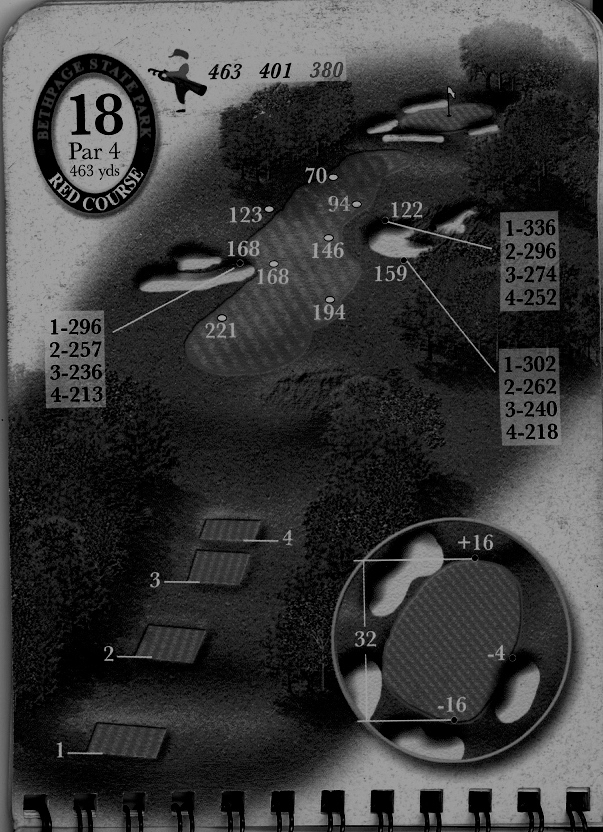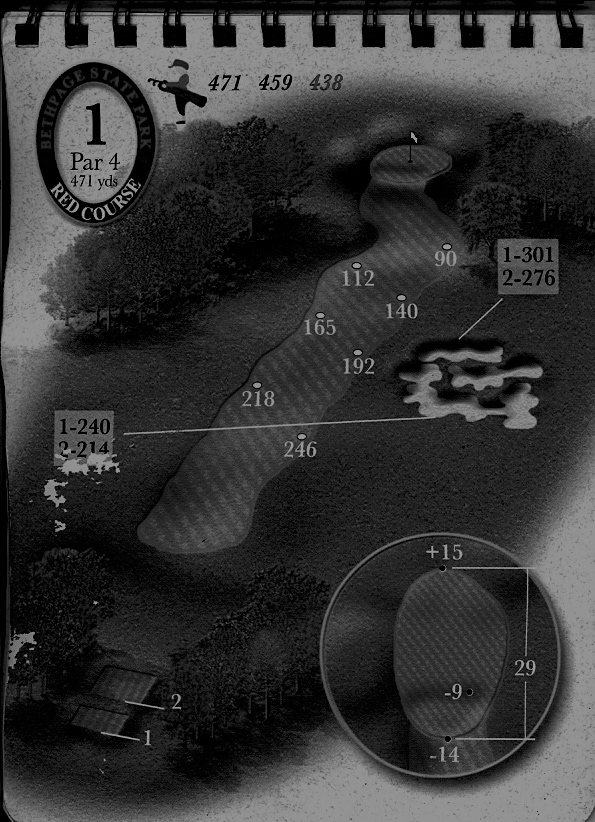Bethpage Black. Our namesake. Probably the most touted municipal course in the land. You arrive at the first tee and the classic sign subtly informs you that you are about to be destroyed.
Truth is they need that sign, because the holes you can see from the clubhouse are…less than incredible? You might even believe, based on the first and final holes at Black, that you could survive the round. And that’s why we need to be replaced for professional tournaments. As in real life, it’s the parts you can’t see that are truly horrifying. Maybe that was all part of Tillinghastly’s plan…to lure you into a false sense of ease before you cross Round Swamp Road on the way to No. 2, where it gets real. But the two holes you can see from the clubhouse don’t quite match the monstrosity that is Black, and both have willing, aggressive substitutes from the course’s underrated, uncomfortable brother.
Bethpage Red cannot compare to this year’s PGA Championship host. Bethpage Black will eat you alive. But Red will at least eat your lunch (after having beaten you up and stolen it). “Settling” for Red is like “settling” for a boxing match with Larry Holmes because you couldn’t get Ali. From the “medium” tees, it plays 6,600 yards…and that’s the only option if you’re a bogey golfer. Considering the dearth of Par 5s on Red, that includes six Par 4s over 400 yards…and another three that toe the line.

Rumors of bringing Red’s less comfortable representatives into play for a professional event have been on the table for years. This conversation typically begins and ends with the concluding hole. Black’s closer is strangely comfortable after a litany of Bell Witch-length Par 4s. Playing just 411 yards from the back, it’s a hole that crushes the everyday player while boring the pros. We see two huge patches of bunkers pinching both sides of the fairway…but most pros can simply play it safe from the tee. We then two Tillinghast-talon bunkers clawing at the final green…but the pros are much too close to sincerely consider landing in them.
And that’s where Red’s closer comes into consideration. Playing 424 from the tips, it has room to extend up to maybe 474. And where Black just needs a straight shot from a straightforward tee, Red’s drive provides an alley of trees, similar to what has made No. 18 at Augusta so nerve-wracking. The ideal drive will work right-to-left…but a pair of bunkers on the left greet shots that draw too soon, while the pair on the right accommodate those who wait too long to break. Neither leaves a particularly encouraging shot to a green that takes some design cues from the “Short” Par 3 template. Although not playing uphill like Black’s last approach, a front pin placement could make for exciting risk-reward opportunities in the last round.
FULL DISCLOSURE: ARGUABLY THE AUTHOR’S GREATEST SHOT EVER CAME FROM THE FRONT-LEFT BUNKER TO HOLE OUT TOWARD THIS VERY PIN AND AN IMPROBABLE BIRDIE. AND HE WILL FOR SURE BE TELLING EVERYONE HE KNOWS ABOUT THIS AS SOON AS BETHPAGE / PGA / USGA DECIDE TO SWAP NO. 18 OVER HERE.
Again, that’s normally where the hole-swap discussion begins and ends at Bethpage. But if golfers can be expected to walk from the Black 17 green to the Red 18 tee box, the trek from the Red 1 green and the Black 2 tee box shouldn’t be too much to ask.

And if any Red hole lives up to Black’s hype, it’s the opener. Sure, the 450-yard dogleg left No. 9 at Red might annihilate more 10-handicapper scorecards than No. 1, but rarely will you feel so screwed over by a course’s first hole than No. 1 at Bethpage Red.
Playing 460 from the middle tees, the first thing on your mind is to avoid cluster terror of bunkers down the right side (you’ll recognize this sand patch from its role along the right fairway on Black’s closing hole). Aiming left isn’t necessarily the best way to deal with the nerves; Slopes coming down from that side mean approaches are potentially blinded by the hump (maybe 110 yards out). And the approach is the tough, no matter where you hit it from. Imagine playing from Black No. 18’s fairway back up to the tee box, and you get an idea. Even if you can see it, you’ll want to hammer-fade left-to-right, following the fairway as it snakes up into the green.
A two-tiered green, that is, where the lower tier catches your noble approach and mocks you with an uphill putt to the other 85% of the green, where the flag inevitably lies. Bethpage Black’s greens are notably plain in their roll, and Red tends to fit this mold. Bethpage doesn’t tier-orize like a Mackenzie course, but the first tier you’ll meet at Red is a cruel exception.
When you approach a course and it features a sign begging you not to waste your time, you expect a bad mother like Red’s No. 1 to greet you. Not the “meh” dogleg right at Black.
Bethpage should do right and bring Red No. 1 into the fold, even if they opt to keep Black No. 18. It’s one of the toughest openers in the country, and it’s so on-brand for everything Bethpage Black has ever sold.